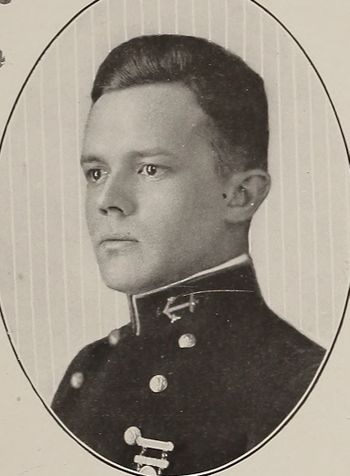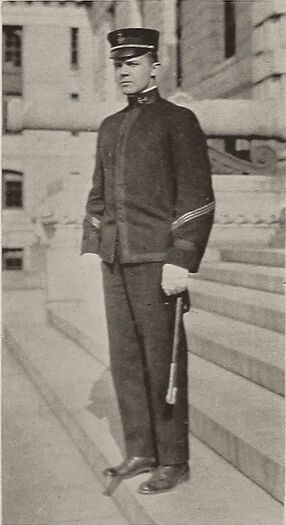HARRY G. SKINNER, JR., ENS, USNRF
Harry Skinner, Jr. '13
Lucky Bag
From the 1913 Lucky Bag:
Harry George Skinner, Jr.
Mt. Washington, Maryland
"Harry"
FIRST Debutante: "Who is that handsome, dark-eyed man with the Hop Committee belt?"
Second Debutante: "Why, don't you know Harry Skinner up in Baltimore?"
And so it goes, while the ordinary Mutt and Jeff brand of fussers tear their hair, despairing of ever getting such attention. Harry came to Crabtown on the 1913 Special after missing one or two other through trains, so he was pretty well acquainted with the route, and has never found traveling arduous at any stage of the game. His work in the gymnasium has been his pastime, and he has made it well worth while, having been an ornament to the team for three creditable years. Youngster Year he joined an association for the promotion of social athletics, but the organization came to grief, and Harry spent the rest of the year keeping trysts inside the yard.
Skinner is very fond of an argument, and sometimes warms up to the point of letting the sparks fly, but he always has the courage of his convictions. There isn't a better comrade and shipmate to be found in the class. He and Robbie have been inseparable; Harry even spends his leaves in New York. This has become such a habit with him that we no longer credit the Damon and Pythias theory, but incline to the old adage, "Cherchez la femme."
Gymnasium Team GNt, Football Numerals, Marksman's Silver Medal, Sharpshooter, Hop Committee, Class Pin Committee, Buzzard
Harry resigned on June 7, 1913; it's unclear if he was refused or if he denied a commission. He is listed as a graduate of the Class of 1913.

Harry George Skinner, Jr.
Mt. Washington, Maryland
"Harry"
FIRST Debutante: "Who is that handsome, dark-eyed man with the Hop Committee belt?"
Second Debutante: "Why, don't you know Harry Skinner up in Baltimore?"
And so it goes, while the ordinary Mutt and Jeff brand of fussers tear their hair, despairing of ever getting such attention. Harry came to Crabtown on the 1913 Special after missing one or two other through trains, so he was pretty well acquainted with the route, and has never found traveling arduous at any stage of the game. His work in the gymnasium has been his pastime, and he has made it well worth while, having been an ornament to the team for three creditable years. Youngster Year he joined an association for the promotion of social athletics, but the organization came to grief, and Harry spent the rest of the year keeping trysts inside the yard.
Skinner is very fond of an argument, and sometimes warms up to the point of letting the sparks fly, but he always has the courage of his convictions. There isn't a better comrade and shipmate to be found in the class. He and Robbie have been inseparable; Harry even spends his leaves in New York. This has become such a habit with him that we no longer credit the Damon and Pythias theory, but incline to the old adage, "Cherchez la femme."
Gymnasium Team GNt, Football Numerals, Marksman's Silver Medal, Sharpshooter, Hop Committee, Class Pin Committee, Buzzard
Harry resigned on June 7, 1913; it's unclear if he was refused or if he denied a commission. He is listed as a graduate of the Class of 1913.
Loss
Harry was lost on November 19, 1917 when USS Chauncey (Destroyer No. 3) sank following a collision with the British merchant steamer she was escorting west of Gibraltar.
Other Information
From researcher Kathy Franz:
In 1900 Harry’s father combined his three-generation ship building company with the Baltimore Dry Docks and Shipbuilding Company, capitalized at $1.6 million each. Harry’s great grandfather had started the company in 1830, and in the late 1890s, it was called William Skinner & Sons ship builders.
Per The Baltimore Sun, July 28, 1907:
Boys Saved Woman’s Life
Rescue at Ocean City By Howard And Harry G. Skinner, Jr.
Mrs. Muir, wife of Captain Muir, of Washington, was saved from drowning at Ocean City, Md., last Sunday by Harry G. Skinner, Jr., 18 years old, and Howard Skinner, 16 years old, sons of Mr. and Mrs. Harry G. Skinner, of Mount Washington.
A crowd was enjoying the surf when a cry for help rang out. The Skinner boys ran along the beach to where a woman’s head bobbing up and down in the breakers beyond the safety line was pointed out to them as drifting out to sea. The brothers leaped into the foam and fought their way to the woman and then began to tug her landward. It was a hard task, so rigorous that Howard Skinner had to give up from exhaustion and get ashore by his own efforts. Harry hung on to Mrs. Muir, and amid cheers from the crowd on the beach he landed his burden on the sand so utterly weak that medical attention had to be given. The young hero’s first attention was to see how his brother had fared and then to be caressed by his mother, who, with Mr. Skinner, had watched the rescue from the boardwalk.
Per The Baltimore Sun, June 21, 1908:
Albert Baker, Howard and Harry Skinner of Mount Washington, sailed the yacht Duane, of the Baltimore Yacht Club, to Claibourne Friday, where she was loaded on a car and shipped to Ocean City. The Duane is one of the fastest half-raters around Baltimore and will be raced this summer against the fastest skiffs on the Sinepuxent.
Harry’s mother was Gertrude, his brothers were Thompson, William Howard, Claude, and William Henry. His sisters were Margaret and Gertrude. In November 1917 most of the family was involved in government work. Harry’s father was marine superintendent of the Baltimore Expeditionary Depot. His mother was chairwoman of the Mount Washington Unit of the Navy League. It held card parties to raise money to purchase wool for navy outfits for the USS Nahma. Harry was on this ship at the time. One of his brothers named William was with the 117th Trench Mortar Battery, and the other was at Camp Meade. Thompson was engaged in the shipbuilding business, and sister Margaret was stenographer in a Food Administration office. Brother Claude was to enter the service shortly.
Harry had left the navy in December 1913, a few months after graduation, because of "defective vision." In 1916 he was working in an office on the 9th floor of the American Building. The Baltimore Sun newspaper reported that he re-enlisted in the Naval Reserve the winter before his death when it was evident that war was imminent. He was on the USS Nahma, an armed yacht acquired by the Navy on a free lease from the Goelet family. She reported to Gibraltar to join other American vessels as convoy escorts in the Mediterranean. Harry sent a postal card in November that he would be home for the holidays. He was traveling on the USS Chauncey went it collided with the British ship SS Rose one minute after seeing her. The Chauncey sunk in one hour at 1:47 a.m. Also lost were the ship’s crew, Lieutenant Commander Walter Reno (Class of 1905) and Lieutenant (jg) Charles Wedderburn (Class of 1915).
He was survived by his parents and two sisters.
Photographs
Memorial
Harry's classmates erected a plaque in his honor in Memorial Hall.
The "Register of Commissioned and Warrant Officers of the United States Navy and Marine Corps" was published annually from 1815 through at least the 1970s; it provided rank, command or station, and occasionally billet until the beginning of World War II when command/station was no longer included. Scanned copies were reviewed and data entered from the mid-1840s through 1922, when more-frequent Navy Directories were available.
The Navy Directory was a publication that provided information on the command, billet, and rank of every active and retired naval officer. Single editions have been found online from January 1915 and March 1918, and then from three to six editions per year from 1923 through 1940; the final edition is from April 1941.
The entries in both series of documents are sometimes cryptic and confusing. They are often inconsistent, even within an edition, with the name of commands; this is especially true for aviation squadrons in the 1920s and early 1930s.
Alumni listed at the same command may or may not have had significant interactions; they could have shared a stateroom or workspace, stood many hours of watch together… or, especially at the larger commands, they might not have known each other at all. The information provides the opportunity to draw connections that are otherwise invisible, though, and gives a fuller view of the professional experiences of these alumni in Memorial Hall.
January 1914
Memorial Hall Error
Harry is listed on the killed in action panel at the front of Memorial Hall. His loss is more accurately characterized as operational, though, as there were no enemy forces in the area (and he was a passenger aboard the vessel). Harry is also listed with his classmates as "USN," but he was a member of the "United States Naval Reserve Force." (Listed as such in the Register of Commissioned and Warrant Officers of the United States Navy and Marine Corps of 1918 and on the separate plaque in Memorial Hall.)

The "category" links below lead to lists of related Honorees; use them to explore further the service and sacrifice of alumni in Memorial Hall.
